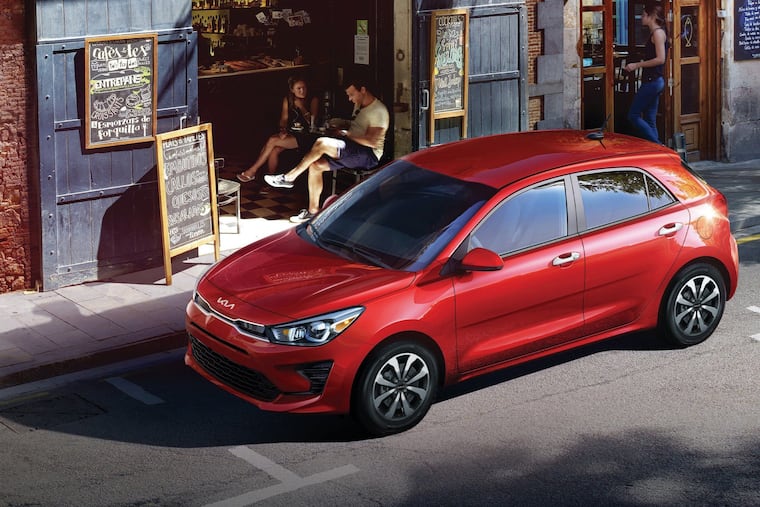Kia Rio stands out among dwindling tiny-car competition
And then there were four: Subcompact offerings in the United States have dwindled to just a handful: Kia, Hyundai, Nissan, and Chevrolet.

2022 Kia Rio 5-Door: Small but mighty?
Price: $20,200 as tested (for 2021). Technology Package added a bevy of safety features, push-button start, and more for $1,800; a full array of mats and cargo net added $415.
Conventional wisdom: Car and Driver likes the “simple yet elegant cabin, ride, and handling transcend price point, standard Apple CarPlay and Android Auto,” but not the “cramped rear quarters, limited driver-assistance features, cargo space isn’t a strong suit.”
Marketer’s pitch: “Five doors of fun.”
Reality: Little cars have come a long way, and the Rio has, as well.
What’s new: It’s getting harder to find a cheap subcompact. Gone from the States are the Honda Fit, as well as Toyota Yaris and its various incarnations.
All we have left to choose from are the Rio — confirmed just this week by Kia — Hyundai Accent, Chevrolet Spark, and Nissan Versa. Beyond that we start at $20,000 and up (which means expect to pay $25-30K).
Up to speed: The Kia Rio — I tested a 2021, but they’re really the same from year to year — is actually a sprightly little car. The 1.6-liter four creates a minimal 120 horsepower, and it sends the vehicle to 60 mph in a leisurely 8.5 seconds, according to a Car and Driver test of the 2018 model. But sport mode adds oomph in the 20-45 range, and that’s a great place to have it, if you’re not doing a lot of highway driving.
Shiftless: I fully expected the CVT to sap all the joy from such a tiny unit, but it was not at all true. Whether letting the unit do all the work or shifting the “gears” oneself, the little hatchback kept up plenty of momentum over hills and downshifting around curves. Only entering a highway or starting out from zero on a grade resulted in loud engine noise and a feeling of inadequacy.
This is the only transmission available, though. Sigh. Among the small competitors, only the Versa and Spark have a stick available in the 2022 model year.
On the road: The Rio offers pretty good handling in regular mode, although it tosses passengers from side to side on the curves.
Hidden on the console under my phone until the final test day, though, lay a Sport mode button, which turned the curves into a more sporty ride. It’s no sports car, but the game is seriously improved.
Either way, good highway manners can be difficult for small-but-tall hatchbacks. It can be hard to keep in a straight line even in a light wind, and road seams and bumps are enhanced.
Another drawback — as with many small cars — is provided by discourtesy of other drivers. They tended to pull in front of the Rio and otherwise ignore me on the highway. “But I’ll be driving a Pathfinder soon enough,” I shouted to the road, “and then won’t you be sorry!”
Driver’s Seat: The welcome into the Rio is less than. The cloth seats felt thin and small, and the manual operation didn’t have nearly as many adjustments as one would hope.
The most severe oversight lies in the steering column: Though the wheel tilts, it does not telescope. I sit very close to the wheel by American standards, but still I find the steering wheel sits too far away from me. I must be built like a T-Rex.
In the Rio, the matte gray-and-black dashboard, plastic steering wheel, and hard door panels all look and feel cheap, which only reflects the price point (although the Versa does this part better).
Friends and stuff: No one else in the family found the passenger seat as whine-worthy as I found the driver’s seat, so perhaps the vehicle is still worth a look, for you tougher buyers out there. (I mean, this is a guy who moans about an Audi Q5. What a wuss.)
» READ MORE: Audi’s small luxury Q5 SUV is neither plush nor sporty
The backseat is really tight. Headroom is good — see tall, upright hatchbacks, above — but legroom is really cramped. Foot room is OK.
The seat back sits fairly upright. The center passenger won’t feel too squeezed by console or hump but, instead, will be shoulder to shoulder and hip to hip (cue the B-52s) with their neighbors.
Cargo space is 17.4 cubic feet with the rear seat up and 32.8 when it’s folded. A hatchback is really the only way to go, though it’s a premium price over the sedan.
Play some tunes: The standard-issue Kia stereo offers fairly easy operation, with knobs for volume and tuning and an 8-inch touchscreen for everything else.
Playback is quite nice, especially for the price, about a B+ or A-.
Night shift: The headlights shine where you need them to. Overhead lights are a tad bright but not too bad.
Fuel economy: I averaged just under 34 mpg in a mostly high-performance test around Chester County country roads. Feed the Rio whatever.
Where it’s built: Pesquería, Mexico
How it’s built: Consumer Reports predicts the reliability to be a 3 out of 5, but without reporting any data for models dating back to 2013. So use that nugget of information as you will, although I don’t see alternative reporting sources available.
In the end: I know EVs and hybrids would be a great solution for penny-pinching buyers; manufacturers have to figure out how to fix that price point.